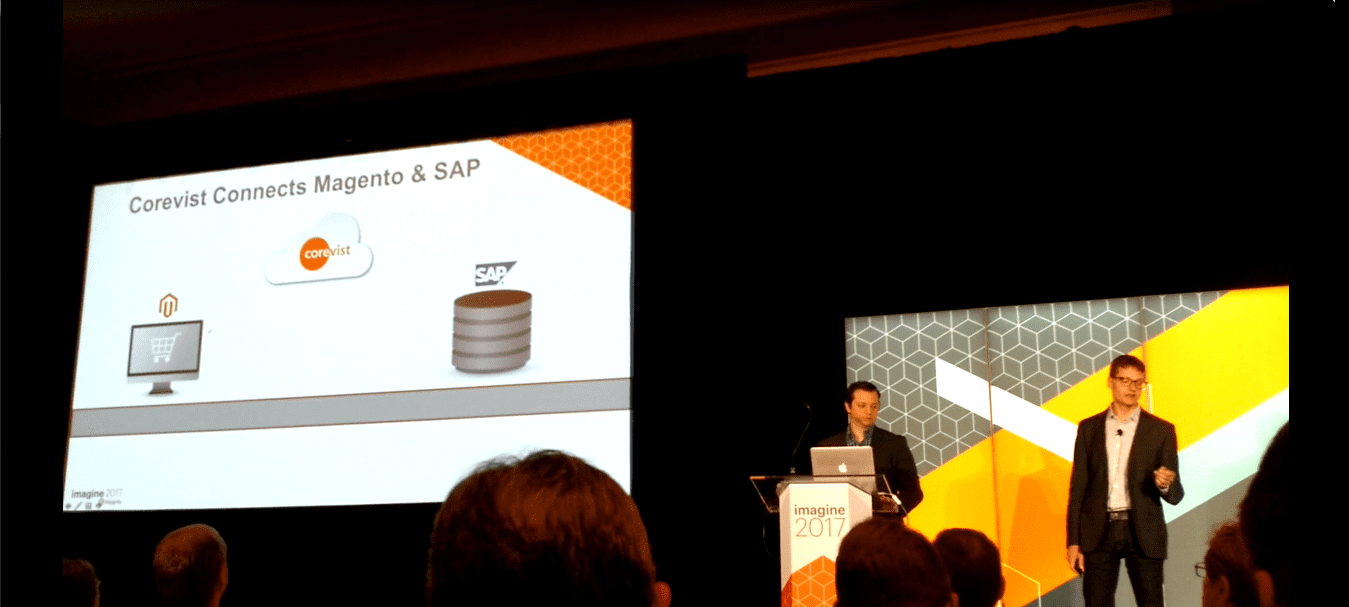Share
Author
George Anderson
Share
Magento Imagine 2017: B2B, SAP, and More
At Corevist, we were delighted to attend Magento Imagine 2017. We connected with numerous people in the Magento ecosystem. We learned a lot about the challenges that the Magento community is tackling, and we were able to talk to people about the Corevist solution that connects Magento to SAP.
I interviewed Ariel Mordetsky, our Director of Sales; and Noah Scribner, our Magento Practice Manager, on their experience at Imagine 2017.
Above: A Magento speaker outlines the Corevist solution for B2B eCommerce.
Exciting B2B Developments at Magento
George: How is Magento poised to meet the needs of the B2B eCommerce market?
Ariel: As a Magento technical partner specializing in SAP integration, we’re very excited to see Magento come out with a B2B extension for their eCommerce platform. We’re looking forward to integrating with it to meet the needs of the B2B community.
Noah: Magento is evolving into the B2B space. We’re excited to partner with them. There’s still a lot of communication that needs to happen within this space, though. “B2B eCommerce” is a bit of a buzzword, and it can mean 15 different things to 15 different people. At Imagine, our challenge was to explain the complexity of what we do—which is integrate enterprise versions of SAP and Magento.
Also, the cloud hosting solution that Magento is pushing looks very interesting. Along with that, we’re excited to learn more about the business intelligence suite that Magento is developing. That will be especially interesting as we continue to define and build out our roadmap of features that support Magento. That data might actually live in Magento. Seeing Magento reinvest in more functionality within the product itself is very exciting to us.
Ariel: It was also refreshing to hear that Magento is gearing up to do a big push in the B2B space, from a marketing perspective. They’re starting this with their 2.2 release, which is set for August 2017. To hear that they’re getting ready to reach a new segment of businesses for the first time, to build a demand engine, is exciting for us in a sales and marketing dimension.
George: What did you learn at Imagine that indicates where Magento B2B eCommerce is headed?
Ariel: It’s great to learn from the Magento ecosystem that the average Magento implementation uses over 7 Magento connectors. I think there’s a great opportunity for existing solution partners and Magento partners to leverage the Corevist B2B connector as part of the solution set. There’s a real need for this in the market, and that was good to hear.
Noah: The other key takeaway from Imagine was hearing how the community of Magento solution providers and their customers are trying to solve their business problems. We learned a lot about the methods they’ve tried—what worked, and what didn’t. We realized that we offer something that the market desperately needs: a trusted resource for the SAP community.
The level of complexity you see with SAP is an order of magnitude higher than your typical entry-level Magento customer. We’ll continue to provide more robust functionality for SAP clients and better leverage the Magento platform as Magento grows their set of solution tools.
Corevist + Magento = New Market Opportunities
George: How is Corevist positioned to deal with that complexity?
Noah: Our internal SAP resources set us apart. That’s our value proposition: we know SAP. We can translate those requirements into actionable items within the Magento system.
Ariel: We have almost 10 years of real life implementations under our belts. No one else has our track record in the SAP B2B enterprise environment. As Magento moves upstream, we welcome them to our sweet spot. We’re excited to keep climbing together.
George: How can the Magento community adapt to this new market?
Ariel: Because of the complexity around SAP ERP solutions, make sure that you’re working with a trusted technology partner who not only understands SAP, but also understands Magento. Don’t fight the battle yourself. Trust us—we’ve seen it before. A lot of DIYers come back to us in a few years and say, “This looks like spaghettiware. Can you fix it?” That’s a real quote from a client, by the way.
Noah: I think the keys will be continuing to embrace the agile mentality for development. That means recognizing that duplication of system efforts always produces unnecessary complexity. In turn, that complexity creates new problems.
Why not take the most efficient path to the solution? If a system already performs the action, and you can tap into that system, you don’t have to reinvent the wheel.
Unfortunately, we see this a lot—solutions that do reinvent the wheel, because the solution provider doesn’t understand what SAP does. They build a redundant system, and it never syncs right.
George: What due diligence should Magento solution providers perform when working with an enterprise client?
Noah: We strongly recommend that the Magento community identify the systems of record early in the process. With us, it’s SAP. Across the Magento community, it could be another ERP system, maybe Magento itself, maybe SalesForce.
Bottom line, you can only have one system driving the ship. Every Magento B2B eCommerce project needs to start with that understanding, regardless of what the ERP system is.
George: Any final thoughts on Magento Imagine 2017?
Ariel: It was good to hear from folks who aren’t on SAP, but have other complex ERP systems. We realized that they’re also trying to figure out how to integrate into Magento. They were probing us for tactics to see if they could apply it to their ERP systems, like AS400 and others. The things we do, we were asked to replicate them for other ERPs.
Noah: Right, we realized everyone is dealing with similar challenges across different stacks. It just confirmed what we’ve known all along—that our solution hits the sweet spot in our market.









